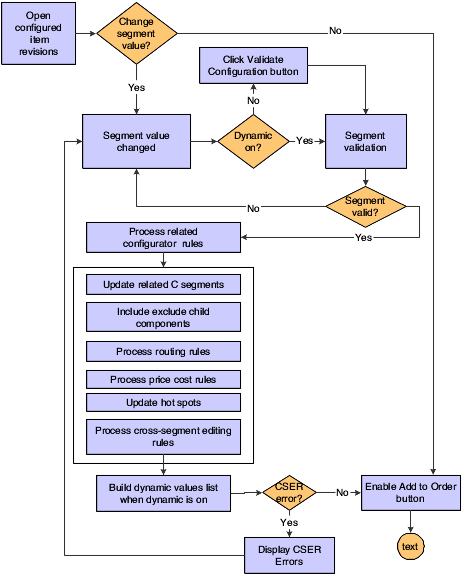Rules Processing
You enter an order for a configured item once the Configured Item form is rendered and the grid is loaded. As you enter an order, the system verifies JD Edwards EnterpriseOne Configurator processes level by level in this order:
Change segment values or click the Add to Order button to accept all default values.
If non-dynamic or dynamic rules processing is enabled, each time a segment answer is changed and is valid; all of the configuration rules that reference the segment are marked for processing. The rules are then processed based on the dynamic configuration entry setting.
If single pass processing is enabled, the system marks all segments as changed and marks all assembly inclusion and cross-segment editing rules for processing. The system processes all rules only once in top down order.
Validate segment agreement.
System processing includes UDC validation, range checking, alpha versus numeric checking, length checking, and required versus optional checking.
Process assembly inclusion rules.
For non-dynamic and dynamic, the system processes rules related to changed segments only. For single pass, the system processes rules for all segments.
Process C assembly inclusion rules and update C segments.
The system processes C rules first because the calculated segment answer might be required to validate the configuration. The calculated segment answer might also be needed to perform additional calculations for the configured item.
Process P assembly inclusion rules.
Process Q assembly inclusion rules.
The system processes Q assembly inclusion rules and stores the components in the Configurator Component table (F3215). The components are used by Sales Quotes (P4210) to establish cost and Order Processing (R31410) to create the parts list and establish cost.
Process R assembly inclusion rules.
The system processes R assembly inclusion rules and stores the routings in the Configurator Routings table (F3212). The routings are used by Sales Quotes (P4210) to establish cost and Order Processing (R31410) to create the routing and establish cost.
Process X assembly inclusion rules.
Process H assembly inclusion rules.
Process cross-segment editing rules.
For non-dynamic and dynamic, the system processes rules related to changed segments only. For single pass, the system processes rules for all segments.
If dynamic configuration entry is disabled, the system displays any error messages.
If dynamic configuration entry is enabled, the system:
Updates all allowed values for other segments to include only valid values.
Sets the valid value if there is only one allowed valid value for a segment.
Removes the segment from the configuration if there are no valid values left for a segment.
See Cross-Segment Editing Rules Editing Process for Dynamic Configuration.
Enable the Add to Order button if no cross-segment editing errors occurred.
Click the Add to Order button.
The following diagram illustrates rules processing:
